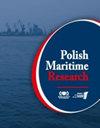自动驾驶仪PID控制器的一致性设计
IF 2
3区 工程技术
Q2 ENGINEERING, MARINE
引用次数: 1
摘要
摘要提出了一种一致的方法来开发船舶自动驾驶仪航向保持和路径跟踪PID控制器的调谐规则。一致性来自于对每个控制器的观察,即受控对象可以由具有惯性的积分器建模。在航向控制器的情况下,它是众所周知的Nomoto模型。PID控制器可以以串联或并联的形式实现,其结果是系统的二阶或三阶,由双闭环或三闭环时间常数指定。新的调整规则可以替代[1,2]中给出的标准规则。研究表明,尽管标准规则和新规则的参考响应几乎相同,但新规则对风、波浪或电流等扰动提供了更好的抑制。并联控制器是特别有利的。路径跟踪PID控制器可以提供比传统PI更好的跟踪精度。给出了串级控制系统产生的仿真路径跟踪轨迹。这项研究的新颖之处在于理论上,特别是为两个PID自动驾驶控制器开发了新的调节规则,以改善干扰抑制。本文章由计算机程序翻译,如有差异,请以英文原文为准。
Consistent Design of PID Controllers for an Autopilot
Abstract A consistent approach to the development of tuning rules for course-keeping and path-tracking PID controllers for a ship autopilot are presented. The consistency comes from the observation that for each of the controllers the controlled plant can be modelled by an integrator with inertia. In the case of the course controller, it is the well-known Nomoto model. The PID controller may be implemented in series or parallel form, the consequence of which is a 2nd or 3rd order of the system, specified by a double or triple closed-loop time constant. The new tuning rules may be an alternative to the standard ones given in [1,2]. It is shown that, whereas the reference responses for the standard and new rules are almost the same, the new rules provide better suppression of disturbances such as wind, waves or current. The parallel controller is particularly advantageous. The path-tracking PID controller can provide better tracking accuracy than the conventional PI. Simulated path-tracking trajectories generated by a cascade control system are presented. The novelty of this research is in the theory, specifically in the development of new tuning rules for the two PID autopilot controllers that improve disturbance suppression.
求助全文
通过发布文献求助,成功后即可免费获取论文全文。
去求助
来源期刊

Polish Maritime Research
工程技术-工程:海洋
CiteScore
3.70
自引率
45.00%
发文量
20
审稿时长
>12 weeks
期刊介绍:
The scope of the journal covers selected issues related to all phases of product lifecycle and corresponding technologies for offshore floating and fixed structures and their components.
All researchers are invited to submit their original papers for peer review and publications related to methods of the design; production and manufacturing; maintenance and operational processes of such technical items as:
all types of vessels and their equipment,
fixed and floating offshore units and their components,
autonomous underwater vehicle (AUV) and remotely operated vehicle (ROV).
We welcome submissions from these fields in the following technical topics:
ship hydrodynamics: buoyancy and stability; ship resistance and propulsion, etc.,
structural integrity of ship and offshore unit structures: materials; welding; fatigue and fracture, etc.,
marine equipment: ship and offshore unit power plants: overboarding equipment; etc.
 求助内容:
求助内容: 应助结果提醒方式:
应助结果提醒方式:


